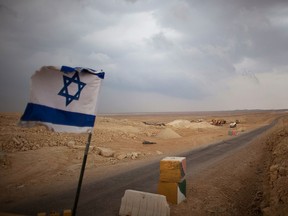Avi Benlolo: Remembering the troubled yet rich history of Jews from Arab lands
Israel prepares to mark the annual memorial day that commemorates the expulsion of Jews from Arab countries and Iran

Article content
Despite the fact Jews were scattered in Arab-dominant lands for more than 2,000 years, their rich history has been mostly silent. However, attention to their plight has gained momentum in the past several years, culminating in the naming of Nov. 30 as an official memorial day to mark their expulsion and departure from Arab countries and Iran. The date was chosen for symbolic reasons as it was soon after the Nov. 29, 1947, United Nations announcement of a partition plan for Israel and an Arab state, that Jews in neighbouring Arab and Persian countries started to experience hostility there.
With the establishment of the Jewish State of Israel in 1948, Arab nationalism and anti-Semitism increased and Jews living in Muslim-majority nations had little choice but to flee. While German Nazism inspired and emboldened violence against Jewish communities between 1940-1945 in Arab-majority lands, the soil was fertile for Arab states to turn against their own Jewish citizens once the declaration for an independent Jewish state had been made in Tel Aviv.
Thus came about the beginning of the end of an incredible and rich history. Palestinians often claim that 1948 was the “nakba” for their descendants. But what is often ignored is that over one million Jews living in Arab lands would also experience their own “catastrophe” that has never been acknowledged or compensated. They became refugees overnight — uprooted from their homes and communities. Most found refuge in the fledgling State of Israel, while others moved to France, Canada and America.
Jews living in Arab lands would also experience their own 'catastrophe'
Their communities, families and cultures were shattered into a million pieces. To put this devastation into perspective, some 265,000 Moroccan Jews left behind their homes; 140,000 Algerian and 105,000 Tunisian Jews locked up their ancient synagogues and cemeteries; 75,000 Egyptian and 135,000 Iraqi Jews closed their schools and businesses; 63,000 Yemeni Jews were airlifted to Israel; and Syrian, Lebanese, Persian, Turkish and Libyan Jews made their dangerous trek to Israel on barges and across deserts.
Despite the fact that many Jews from Arab lands were educated professionals, they faced hardship and often times discrimination in Israel. My own grandparents, having lived a modern, well-heeled cosmopolitan life in Casablanca and having been educated in the Alliance French school system, were sent to a refugee camp in the southern city of Ashkelon. In one of his last letters before passing away from an illness at the young age of 46, my grandfather, Emile Azoulay, spoke of his daily challenges adapting to his new life.
Alongside Jews from Arab lands is a tapestry of Jews from Spain and Portugal, often referred to as Sephardim. Within Sephardic tapestry are many other nationalities including Jews from Italy, Portugal, Spain and Greece. Following the Spanish Inquisition, many more Jews scattered to Arab lands, mainly to Morocco and Turkey. Christian historians recall 1492 as the year Columbus set sail to the New World. Jewish historians recall the date for when Queen Isabella and King Ferdinand of Spain issued a decree to that Jews must convert, leave or die. This is how Ladino (the yiddish for many Sephardic Jews) came to be spoken mostly throughout the Ottoman empire.
The ancient Greek Jewish community of Thessaloniki was completely wiped out by the Nazis who murdered 46,700 people. In fact, had the Holocaust lasted one or two more years, Jews living in Arab lands would have been Hitler’s next target.
The Nazis were establishing fronts all over the Middle East, readying themselves for their next phase of world domination once Europe was taken. Their control of Vichy France now put them in reach of Jewish communities throughout the region. In Morocco, Nazis began to compile lists of Jews and forced to move into ghettos (mellahs). In Algeria they were stripped of their French citizenship, and in Tunisia the SS Einsatzkommando began operations, putting 5,000 Jews to forced labour. In Egypt, SS commander Erwin Rommel created a mobile killing unit to murder Jews there and in the Holy Land.
Some would call the departure of Jews from Arab lands a modern-day exodus to the Jewish homeland. The promised land of our forefathers — Abraham, Isaac and Jacob. The land that Moses would never see, but was promised to him by G-d. The land that Sephardic Jews — along with Ashkenazi Jews — had been praying toward for millennia. “Next year in Jerusalem” they would call out in prayer from the synagogues they had built after being scattered 2,300 years earlier with the destruction of their temple in Jerusalem.
Sephardic Jewry is rich in culture and tapestry. Yet, despite its incredible scholarly and Judaic tradition, it has been left on the margin of history. Among its greatest luminaries was Rabbi Moses ben Maimon, also known as Maimonides — one of the most prolific and influential Torah scholars of the Middle Ages. His “The Guide for the Perplexed” is one of the most cherished books in my library and is venerated by most religious and philosophical scholars.
Justice for Jews from Arab lands means bringing their vibrant history and legacy in from the margins of history.
National Post
Avi Abraham Benlolo is the Founder and Chairman of The Abraham Global Peace Initiative.













Postmedia is committed to maintaining a lively but civil forum for discussion. Please keep comments relevant and respectful. Comments may take up to an hour to appear on the site. You will receive an email if there is a reply to your comment, an update to a thread you follow or if a user you follow comments. Visit our Community Guidelines for more information.